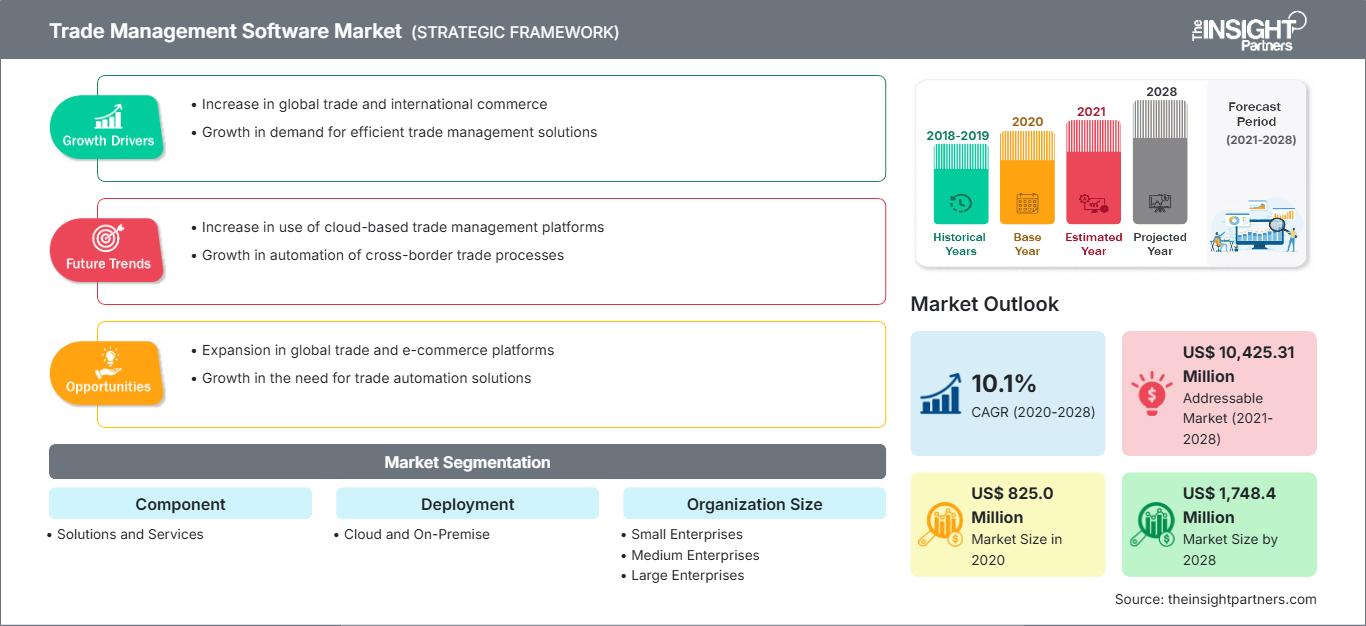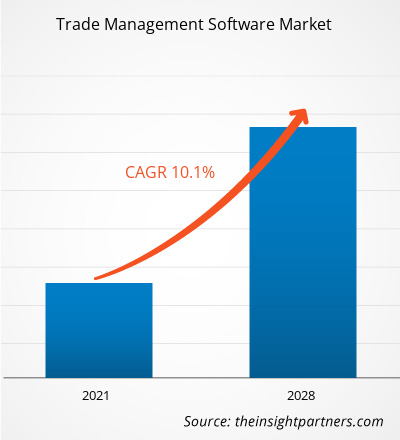[研究报告]就收入而言,2020 年全球贸易管理软件市场价值为 8.25 亿美元,预计到 2028 年将达到 17.484 亿美元;预计在 2020 年至 2028 年的预测期内,复合年增长率将达到 10.1%。
贸易管理软件市场大致分为五大区域——北美、欧洲、亚太地区、中东和非洲地区以及南美地区。2020 年,亚太地区占据了贸易管理软件市场的主导地位。亚太地区由许多发展中国家组成,这些国家的制造业都经历了高速增长;该地区已成为全球制造业中心。中国以及印度、韩国、台湾和越南等其他发展中国家/地区正在吸引众多企业将其中低技能制造设施迁移到劳动力成本较低的邻国。此外,这些国家的政府正在采取措施改善该地区的外国投资。多年来,该地区的制造业支出大幅增长,预计还会以可观的速度增长。制造业支出的大幅增长和新技术的采用是推动该地区对贸易管理软件需求的关键因素。
COVID-19 疫情对贸易管理软件市场的影响
自 2019 年 12 月以来,COVID-10 疫情一直影响着全球的每一项业务。病毒感染患者数量的持续增长迫使政府限制人员和货物的运输。由于工厂暂时停工和产量低,制造业遭受了严重损失,这阻碍了零售、电子商务和物流行业的发展。此外,政府实施的社交或物理隔离措施限制了物流和其他服务提供商的运营。这种中断导致贸易业务下滑。这些不利因素导致2020年5月全球贸易额较2019年5月下降17.7%。2020年前5个月的贸易额下降普遍存在,但主要影响的是日本、美国和欧洲国家的出口。尽管新冠疫情造成了干扰,但随着企业在长期封锁后陆续复工,未来贸易额可能会大幅增长。随着保持社交距离措施的实施,电商、物流、零售等参与贸易活动的行业正致力于采用贸易管理软件,以确保供应链速度并满足合规要求。因此,新冠疫情带来的不确定性扩大了基于云的软件/SaaS在物流领域的应用范围。
自定义此报告以满足您的要求
您将免费获得任何报告的定制,包括本报告的部分内容,或国家级分析、Excel 数据包,以及为初创企业和大学提供超值优惠和折扣
贸易管理软件市场: 战略洞察

- 获取本报告的主要市场趋势。这个免费样本将包括数据分析,从市场趋势到估计和预测。
市场洞察——贸易管理软件市场成本降低和实时可视性
您将免费获得任何报告的定制,包括本报告的部分内容,或国家级分析、Excel 数据包,以及为初创企业和大学提供超值优惠和折扣
贸易管理软件市场: 战略洞察

- 获取本报告的主要市场趋势。这个免费样本将包括数据分析,从市场趋势到估计和预测。
贸易是一个复杂的过程,涉及多种商品和信息在供应商、承运商和仓库网络之间的流动。软件解决方案通过分析实时和现实世界数据,帮助用户更精确、更轻松地处理这些复杂问题,从而减少低效率。这些软件系统的实施还可以改善供应链功能,并提供实时运营可视性。不同行业竞争力的提升是促使它们投资自动化和数字化的主要动力。此外,采用基于云的解决方案可以增强对出口商品的实时可视性,并降低运营成本。区块链、人工智能 (AI) 和预测分析等新兴技术在物流运营中的应用,将在未来几年进一步推动全球贸易管理软件市场的增长。
组件细分洞察
基于组件,贸易管理软件市场细分为解决方案和服务。预计在预测期内,解决方案细分市场将成为全球贸易管理软件市场的领先细分市场。解决方案细分市场包括贸易合规性以及国际贸易可视性和执行。此外,国际贸易可视性和执行运营还包括跨境航运和运输。它们可以洞察国际贸易伙伴的事件和流程。这些流程必须是国际性的,并且包含商业贸易伙伴之间的交易和协议。
部署细分市场洞察
根据部署方式,贸易管理软件市场分为本地部署和云部署。在预测期内,云部署很可能成为全球贸易管理软件市场的主导细分市场。云部署主要被中小型企业采用。低拥有成本、降低维护和升级成本以及能够访问最新功能是云部署相对于本地部署的主要优势。
组织规模细分市场洞察
根据组织规模,贸易管理软件市场分为小型企业、中型企业和大型企业。预计在预测期内,大型企业细分市场将成为全球贸易管理软件市场的主导细分市场。在全球范围内,许多组织对贸易管理软件的需求都在增长,以提高效率并降低总体运营成本。采用此类软件是大型企业构建合适供应链和提高整体运营灵活性的常见做法。
行业细分洞察
基于行业,预计物流和运输行业将在预测期内成为全球贸易管理软件市场的领先行业。对提供超越传统服务的物流供应商的需求正在增长。在某些情况下,第三方物流供应商运营或管理其合作伙伴的外贸区。此外,在其他情况下,他们提供与商品生产或采购相关的仓储以及增值服务。此外,他们还组织所有必要的物流和运输流程,以便高效、经济地将货物从源头转移到最终用户。
市场参与者专注于新产品的创新和开发,将先进的技术和功能融入产品中,从而与竞争对手展开竞争。
- 2021 年 1 月,SAP 香港与咨询巨头德勤合作,为从事跨境贸易的企业提供切实的利益。
- 2019 年 1 月,Bamboo Rose 推出了订阅模式的服务,帮助客户更好地规划、创新并与其多企业零售社区协作,从而节省 10% 到 30% 的技术投资。
- 2019 年 3 月,汤森路透收购了全球贸易管理 (GTM) 软件提供商 Integration Point,交易金额未披露,此举大大扩展了其北美进出口商客户群。
贸易管理软件市场区域洞察
The Insight Partners 的分析师已详尽阐述了预测期内影响贸易管理软件市场的区域趋势和因素。本节还讨论了北美、欧洲、亚太地区、中东和非洲以及南美和中美洲的贸易管理软件市场细分和地域分布。
贸易管理软件市场报告范围
| 报告属性 | 细节 |
|---|---|
| 市场规模 2020 | US$ 825.0 Million |
| 市场规模 2028 | US$ 1,748.4 Million |
| 全球复合年增长率 (2020 - 2028) | 10.1% |
| 历史数据 | 2018-2019 |
| 预测期 | 2021-2028 |
| 涵盖的领域 |
By 组件
|
| 覆盖地区和国家 | 北美
|
| 市场领导者和主要公司简介 |
|
贸易管理软件市场参与者密度:了解其对业务动态的影响
贸易管理软件市场正在快速增长,这得益于终端用户需求的不断增长,而这些需求的驱动因素包括消费者偏好的不断变化、技术进步以及对产品优势的认知度不断提高。随着需求的增长,企业正在扩展其产品线,不断创新以满足消费者需求,并利用新兴趋势,从而进一步推动市场增长。

- 获取 贸易管理软件市场 主要参与者概述
- 解决方案
- 服务
贸易管理软件市场 — 按部署
- 本地
- 云
贸易管理软件市场 — 按组织规模
- 大型企业
- 中型企业
- 小型企业
贸易管理软件市场 — 按最终用户
- 零售和CG
- 汽车
- 物流和运输
- 医疗保健和制药
- 政府
- 航空航天和国防
- 化学品和矿产
- 制造业
- 其他
贸易管理软件市场 –按地区
北美
- 美国
- 加拿大
- 墨西哥
欧洲
- 法国
- 德国
- 意大利
- 英国
- 俄罗斯
- 欧洲其他地区
亚太地区 (APAC)
- 中国
- 印度
- 韩国
- 日本
- 澳大利亚
- 亚太地区其他地区
中东和非洲(MEA)
- 南非
- 沙特阿拉伯
- 阿联酋
- MEA其他地区
南美洲(SAM)
- 巴西
- 阿根廷
- SAM其他地区
贸易管理软件市场 –公司简介
- Amber Road, Inc.
- Bamboo Rose LLC
- Expeditors International of Washington, Inc.
- Integration Point, LLC
- Livingston International
- MIC
- Oracle Corp
- QAD, Inc
- QuestaWeb
- SAP SE
- 历史分析(2 年)、基准年、预测(7 年)及复合年增长率
- PEST和SWOT分析
- 市场规模、价值/数量 - 全球、区域、国家
- 行业和竞争格局
- Excel 数据集
近期报告
相关报告
客户评价
购买理由
- 明智的决策
- 了解市场动态
- 竞争分析
- 客户洞察
- 市场预测
- 风险规避
- 战略规划
- 投资论证
- 识别新兴市场
- 优化营销策略
- 提升运营效率
- 顺应监管趋势






















 获取免费样品 - 贸易管理软件市场
获取免费样品 - 贸易管理软件市场